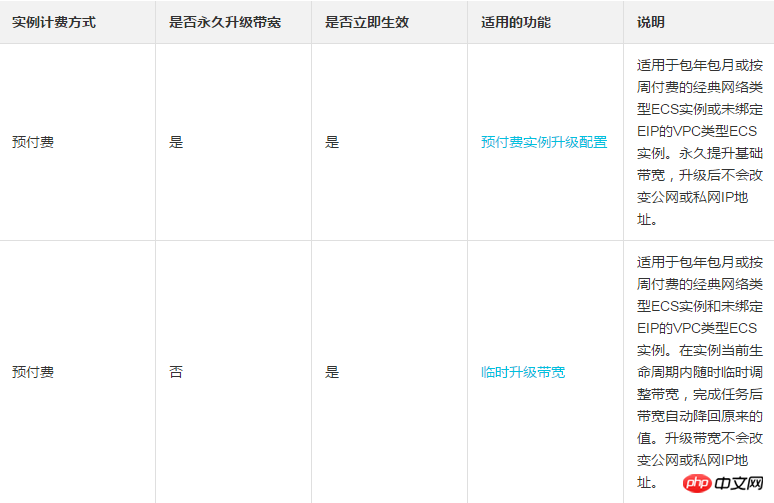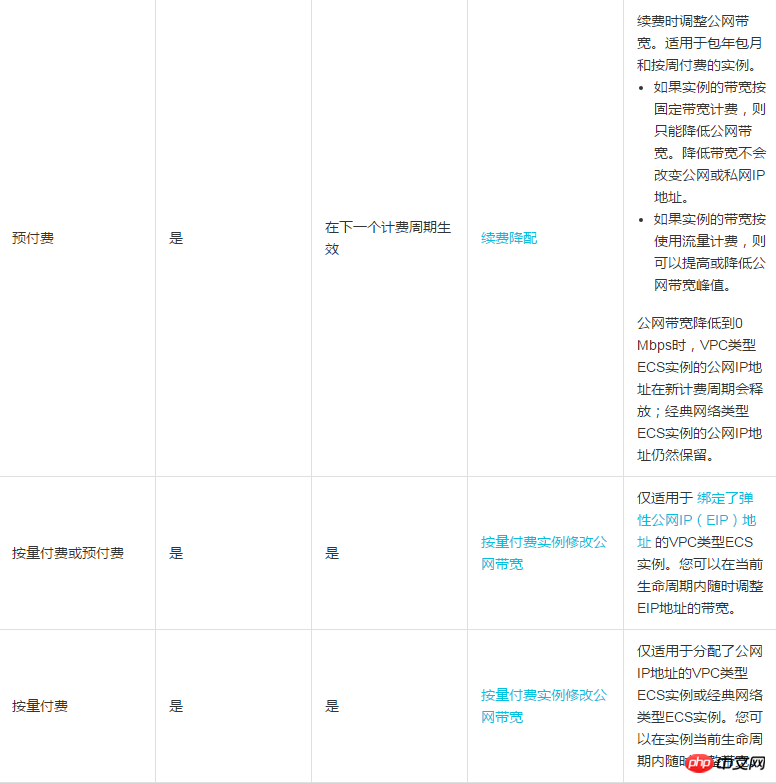 Operation and Maintenance
Operation and Maintenance
 Linux Operation and Maintenance
Linux Operation and Maintenance
 How to upgrade or downgrade instance configuration after creating an instance
How to upgrade or downgrade instance configuration after creating an instance
How to upgrade or downgrade instance configuration after creating an instance
This article introduces how to upgrade or reduce the instance configuration after creating an instance, and focuses on using different functions to modify the instance configuration.
After creating an instance, you can modify the configuration of the instance and public network bandwidth.
Upgrading or downgrading instance configuration
You can only upgrade or downgrade the number of vCPU cores and memory size (i.e. instance specification family) of an instance at the same time, and cannot adjust one configuration individually. Depending on the billing method of the instance, you must use different functions to modify the instance configuration:
Prepaid:
Upgrade instance configuration: Use the Prepaid instance upgrade configuration function to upgrade the instance specifications at any time. After the operation is completed, you must restart the instance or use the RebootInstance interface to restart the instance for the new configuration to take effect. Applicable to annual and monthly subscription instances and paid-per-week instances.
Reduce instance configuration: Use the Renewal Downgrade function to reduce instance specifications while renewing. After entering the new billing cycle, you need to restart the instance on the console within 7 days to make the new instance specifications take effect. Applicable to annual and monthly subscription instances and paid-per-week instances.
Pay-as-you-go:
Use the pay-as-you-go instance change instance specification function to modify the configuration of the pay-as-you-go instance. You must stop the instance to use this feature.
Description
Stopping the instance will interrupt your business. It is recommended that you perform the operation when the business is at a low point.
Adjust public network bandwidth
Depending on the instance's billing method and bandwidth requirements, you can modify the public network bandwidth in different ways, as shown in the following table.


Assign a public IP address after creating the instance
In step 2: When creating an ECS instance, you can pass Set the public network bandwidth to a non-zero value and assign a public IP address to the ECS instance. If no public IP address is assigned at this time, after the instance is successfully created, you can assign a public IP address to the instance through different functions. However, currently only prepaid instances can be assigned a public IP address after they are successfully created. Details are shown in the table below.

Change the public network bandwidth billing method
Depending on the billing method of the instance, you can change the public network bandwidth billing method in different ways:
Prepaid: Applicable to classic network type ECS instances or VPC type ECS instances without EIP bound.
Billing based on usage traffic —> Billing based on fixed bandwidth: You can use the prepaid instance upgrade configuration function, which takes effect immediately. Applicable to annual, monthly and weekly paid instances.
Billing based on fixed bandwidth —> Billing based on usage traffic: You can use the "Renewal and Downgrade" function to change the billing method for public network bandwidth during renewal. Changes will not take effect until you enter a new billing cycle. Applicable to annual, monthly and weekly paid instances.
Pay-as-you-go: Applicable to VPC type ECS instances or classic network type ECS instances that have been assigned public IP addresses. You can use a pay-as-you-go instance to modify the public network bandwidth and change the public network bandwidth billing method at any time. Effective immediately.
The above is the detailed content of How to upgrade or downgrade instance configuration after creating an instance. For more information, please follow other related articles on the PHP Chinese website!

Hot AI Tools

Undresser.AI Undress
AI-powered app for creating realistic nude photos

AI Clothes Remover
Online AI tool for removing clothes from photos.

Undress AI Tool
Undress images for free

Clothoff.io
AI clothes remover

AI Hentai Generator
Generate AI Hentai for free.

Hot Article

Hot Tools

Notepad++7.3.1
Easy-to-use and free code editor

SublimeText3 Chinese version
Chinese version, very easy to use

Zend Studio 13.0.1
Powerful PHP integrated development environment

Dreamweaver CS6
Visual web development tools

SublimeText3 Mac version
God-level code editing software (SublimeText3)

Hot Topics
 deepseek web version entrance deepseek official website entrance
Feb 19, 2025 pm 04:54 PM
deepseek web version entrance deepseek official website entrance
Feb 19, 2025 pm 04:54 PM
DeepSeek is a powerful intelligent search and analysis tool that provides two access methods: web version and official website. The web version is convenient and efficient, and can be used without installation; the official website provides comprehensive product information, download resources and support services. Whether individuals or corporate users, they can easily obtain and analyze massive data through DeepSeek to improve work efficiency, assist decision-making and promote innovation.
 How to install deepseek
Feb 19, 2025 pm 05:48 PM
How to install deepseek
Feb 19, 2025 pm 05:48 PM
There are many ways to install DeepSeek, including: compile from source (for experienced developers) using precompiled packages (for Windows users) using Docker containers (for most convenient, no need to worry about compatibility) No matter which method you choose, Please read the official documents carefully and prepare them fully to avoid unnecessary trouble.
 BITGet official website installation (2025 beginner's guide)
Feb 21, 2025 pm 08:42 PM
BITGet official website installation (2025 beginner's guide)
Feb 21, 2025 pm 08:42 PM
BITGet is a cryptocurrency exchange that provides a variety of trading services including spot trading, contract trading and derivatives. Founded in 2018, the exchange is headquartered in Singapore and is committed to providing users with a safe and reliable trading platform. BITGet offers a variety of trading pairs, including BTC/USDT, ETH/USDT and XRP/USDT. Additionally, the exchange has a reputation for security and liquidity and offers a variety of features such as premium order types, leveraged trading and 24/7 customer support.
 Ouyi okx installation package is directly included
Feb 21, 2025 pm 08:00 PM
Ouyi okx installation package is directly included
Feb 21, 2025 pm 08:00 PM
Ouyi OKX, the world's leading digital asset exchange, has now launched an official installation package to provide a safe and convenient trading experience. The OKX installation package of Ouyi does not need to be accessed through a browser. It can directly install independent applications on the device, creating a stable and efficient trading platform for users. The installation process is simple and easy to understand. Users only need to download the latest version of the installation package and follow the prompts to complete the installation step by step.
 Get the gate.io installation package for free
Feb 21, 2025 pm 08:21 PM
Get the gate.io installation package for free
Feb 21, 2025 pm 08:21 PM
Gate.io is a popular cryptocurrency exchange that users can use by downloading its installation package and installing it on their devices. The steps to obtain the installation package are as follows: Visit the official website of Gate.io, click "Download", select the corresponding operating system (Windows, Mac or Linux), and download the installation package to your computer. It is recommended to temporarily disable antivirus software or firewall during installation to ensure smooth installation. After completion, the user needs to create a Gate.io account to start using it.
 Ouyi Exchange Download Official Portal
Feb 21, 2025 pm 07:51 PM
Ouyi Exchange Download Official Portal
Feb 21, 2025 pm 07:51 PM
Ouyi, also known as OKX, is a world-leading cryptocurrency trading platform. The article provides a download portal for Ouyi's official installation package, which facilitates users to install Ouyi client on different devices. This installation package supports Windows, Mac, Android and iOS systems. Users can choose the corresponding version to download according to their device type. After the installation is completed, users can register or log in to the Ouyi account, start trading cryptocurrencies and enjoy other services provided by the platform.
 gate.io official website registration installation package link
Feb 21, 2025 pm 08:15 PM
gate.io official website registration installation package link
Feb 21, 2025 pm 08:15 PM
Gate.io is a highly acclaimed cryptocurrency trading platform known for its extensive token selection, low transaction fees and a user-friendly interface. With its advanced security features and excellent customer service, Gate.io provides traders with a reliable and convenient cryptocurrency trading environment. If you want to join Gate.io, please click the link provided to download the official registration installation package to start your cryptocurrency trading journey.
 How to Install phpMyAdmin with Nginx on Ubuntu?
Feb 07, 2025 am 11:12 AM
How to Install phpMyAdmin with Nginx on Ubuntu?
Feb 07, 2025 am 11:12 AM
This tutorial guides you through installing and configuring Nginx and phpMyAdmin on an Ubuntu system, potentially alongside an existing Apache server. We'll cover setting up Nginx, resolving potential port conflicts with Apache, installing MariaDB (





